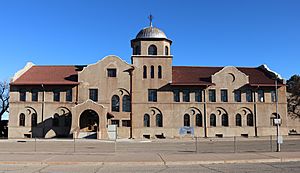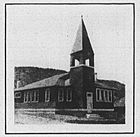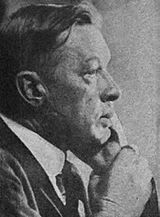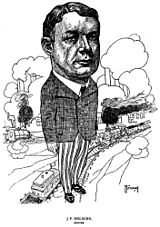Colorado Fuel and Iron facts for kids
The Colorado Fuel and Iron Company (CF&I) was a very large steel company. It started in 1892 when several businesses joined together. By 1903, it was mostly owned by the families of John D. Rockefeller and Jay Gould.
Even though CF&I had many plants across the country, its main one was a huge steel mill in Pueblo, Colorado. This mill was the most important industry in Pueblo for a long time. From 1901 to 1912, Colorado Fuel and Iron was one of the biggest and most important companies in the United States.
However, a big drop in steel prices in 1982 caused the company to struggle. After facing financial troubles several times, it was bought by Oregon Steel Mills in 1993. Its name then changed to Rocky Mountain Steel Mills. In 2007, a Russian steel company called EVRAZ Group bought Rocky Mountain Steel Mills and all of Oregon Steel's other businesses.
CF&I owned more than just the main steel plant. To make steel, they needed many materials. So, over about 100 years, CF&I also owned:
- Coal mines in southern Colorado.
- Iron mines in Wyoming and Utah.
- Limestone quarries.
- Smaller mines for other materials needed to make steel.
- The Colorado and Wyoming Railway to transport everything.
In Redstone, Colorado, hundreds of special ovens called coking ovens turned coal into coke, which is a type of fuel. Mines like Mcnally, Cameron, Robinson, and Walsen near Walsenburg, Colorado, were also owned by CF&I. The company even owned and ran the Colorado Supply company store. They also controlled many furnaces across the country, including one in Birdsboro, Pennsylvania.
Contents
How the Company Started

The first steel mill west of St. Louis was built in Pueblo in 1881. It was built by the Colorado Coal and Iron Company (CC&L). This company was connected to the Denver and Rio Grande Railway Company. The railway's leaders, General William Jackson Palmer and Dr. William Abraham Bell, wanted the mill to make rails for their trains.
The area had many natural resources needed for steel. Water came from the Arkansas River. Coal came from Trinidad, Colorado. Limestone was found a few miles south of Pueblo. Iron ore came from the San Luis Valley. The railway helped transport all these materials.
Making steel using blast furnaces and the Bessemer process started on April 12, 1881. The mill made rails, iron bars, steel plates, and nails.
The idea for the steel works came from the Central Colorado Improvement Company. General William Jackson Palmer started this company in 1872. Its goal was to buy land, minerals, coal, and iron in Colorado. It also planned to build towns, mines, and factories.
Work on the mill began in February 1880. It was first called the Colorado Coal and Steel Works. It was built on a flat area south of what became South Pueblo, Colorado. A neighborhood of homes grew near the works, eventually named Bessemer in 1881. The mill could make about 80 tons of steel per year at first and employed 300-400 people. The first steel rails were made in April 1882 for the Denver and Rio Grande Railroad.
The steel market was tough because of strong competition from mills in the eastern U.S. So, the Pueblo mill was often not busy. The company started making coke and coal instead. They opened more mines near Trinidad, Canon City, Walsenburg, and Crested Butte. Coke ovens were built in El Moro and Crested Butte.
In the early 1890s, the demand for fuel dropped. The company faced strong competition from the Colorado Fuel Company. In 1892, John C. Osgood helped these two companies merge to form the Colorado Fuel and Iron Company. Osgood and other investors took control.
The steel mill in Pueblo was small and old-fashioned. It was often idle in the 1880s and 1890s due to competition and economic troubles. It wasn't until 1899 that the company could make big improvements. They added a rolling mill, more blast furnaces, modern steel-making equipment, a wire mill, and other facilities. In 1901, the mill was renamed the Minnequa Works.
Iron Ore Sources
Early on, CF&I got iron ore from different mines. These included the Calumet Mine north of Salida, Colorado and the Orient Mine east of Villa Grove, Colorado. They also got iron from silver mining in Leadville, Colorado. More iron ore came from New Mexico and Wyoming. The company also bought land with iron ore in Utah.
They built company towns at isolated mines like Orient and Calumet. In 1899, the Calumet Mine closed. Production moved to the Sunrise Mine near Hartville, Wyoming, which CF&I leased in 1898. The Colorado and Wyoming Railway Company was created to transport this ore. The Orient Mine closed in 1905, but some ore was still mined there until 1922. It reopened briefly but closed for good during the Great Depression when demand fell.
Mining at the Sunrise Mine in Wyoming began in 1899. It started as open-pit mining, which was very cheap. By 1900, they were mining 2,000 tons of ore every day. CF&I bought the property in 1904. Even with this, the Minnequa Works in Pueblo still needed more ore. So, they also got ore from mines in Grant County, New Mexico. They bought a lot of land with ore near Cedar City, Utah, but this ore was not mined at that time.
Limestone Sources
Limestone was first taken from a quarry near Pueblo. Later, they found a better quality limestone and dolomite deposit near Howard, Colorado.
Coal and Coke Production

By 1903, CF&I was the biggest producer of coal in the Rocky Mountain West. They had 23 mines in several Colorado counties. These mines produced more than half of all the coal mined in Colorado. Their 9 coking plants made almost all the coke in the state.
Different types of coal were mined for different uses. Coal for boilers and trains came from the Huerfano area. Coal for home heating came from the Canon area. Anthracite coal was mined at Crested Butte.
The demand for coke from the metal mining industry went down. This was because first silver production dropped, and then gold production also decreased. Also, new ways of refining metals didn't need as much coke. Large copper companies like Phelps Dodge and The American Smelting and Refining Company started their own coal mines and coking plants.
Education Efforts
In 1901, CF&I started the Sociological Department. Many of their workers were immigrants. The department wanted to improve the lives of workers and their families. They also aimed to teach them about American ways and the company's values.
The Sociological Department started night schools to teach miners English. They also set standards for education and encouraged miners' children to attend school.
Richard Corwin, a company leader, believed that Kindergarten would help immigrant children become good citizens. In Kindergarten, children learned English and the importance of hard work in factories. The hope was that they would become good future employees for the company.
In 1914, several schools were built, including one in Primero, Colorado. These were part of efforts to gain support for the company.
Land Purchases
In 1900, CF&I expected a high demand for coal. So, they bought large areas of land rich in coal in Colorado. This land was part of the Maxwell Land Grant near Trinidad. They bought it through their company, the Rocky Mountain Coal and Iron Company.
After this purchase, new mines, coking plants, and railway lines were built in 1901 and 1902. These were located west of Trinidad. Facilities for workers were also built under the direction of Dr. Richard W. Corwin, CF&I's chief surgeon.
The 20th Century
The Pueblo steel plant used blast furnaces until 1982. The main blast furnace buildings were taken down in 1989. However, because of asbestos (a type of material), many nearby support buildings still remain. You can easily see these from Interstate 25, which runs next to the plant.
Gould and Rockefeller Take Control
In 1902, CF&I faced money problems. John C. Osgood, the company's founder, asked George Jay Gould I, a major owner of the Denver and Rio Grande Railway, for a loan. Gould then brought in John D. Rockefeller, who created the Standard Oil company, to help with the loan.
John D. Rockefeller, Jr. looked at CF&I's operations. He saw that the company needed a lot more money. This money was provided, and in return, Rockefeller and Gould gained control of CF&I and its smaller companies, like the Colorado and Wyoming Railway. In 1903, control of CF&I moved from Osgood's group to Gould and Rockefeller. Osgood left the company in 1904 to focus on other coal businesses.
Frank J. Hearne, an experienced manager, was hired in 1903 to run CF&I. In 1904, all of CF&I's properties were put under one company called Colorado Industrial Company. This helped manage everything better. Sales increased a lot, but making a lot of profit was hard due to competition from eastern companies.
In November 1903, the United Mine Workers union went on strike at the coal mines near Walsenburg and Trinidad. This strike lasted 11 months. The company fought hard against the strike, using strikebreakers. Steel production went down, but the company managed to keep enough coal for its customers.
After the strike, big investments were made at the mill. They bought water rights in the Arkansas River and built a reservoir. Before, the mill depended on the small and changing flow of the St. Charles River.
Lamont M. Bowers, Rockefeller's relative, became very influential in the company. He was effectively in charge from 1908 to 1915. Bowers worked to make the company profitable. He reduced the number of employees, closed less profitable operations, and cut back on company programs for workers. His efforts worked, and profits increased. The steel mill ran at full capacity. However, making even bigger profits was still hard due to competition and problems shipping coal.
There were several dangerous explosions in the coal mines near Trinidad between 1904 and 1910. These caused many injuries and deaths. To prevent such disasters, the company and the coal mining industry made big improvements in mine safety. This included better mine ventilation, sprinkler systems to keep coal dust wet, and spreading rockdust to prevent explosions. Concerns about mine safety led to the creation of the United States Bureau of Mines in 1907 and new safety rules in Colorado.
Worker Relations
CF&I had many disagreements with its workers throughout its history. The company was accused of being harsh towards the UMWA during a strike in 1903-04. The most famous strike ended in the sad Ludlow Massacre in 1914. Company records show that CF&I tried to spy on, spread negative information about, and break up worker groups.
Many of CF&I's workers were immigrants, especially from eastern and southern Europe. While experienced miners from Cornwall were encouraged to come, many workers were new to mining and didn't speak English well. This made it hard to share safety information.
Lamont M. Bowers, who was in charge, was very against unions. He refused to talk or negotiate with the United Mine Workers before the big strike of 1913-14. This long and difficult strike ended his time with the company.
The 1913–14 Strike
The strike began in September 1913. It was called by the United Mine Workers because they wanted the right to have a union represent them. The strike was against coal mine owners in southern Colorado, where most of CF&I's coal and coke were produced. The coal owners, including CF&I's president Welborn, fought hard against the strike.
Even though few miners were actually union members, most honored the strike. Strikebreakers were sometimes threatened or attacked. Both sides bought many weapons. On October 26, 1913, the governor of Colorado, Elias M. Ammons, sent in the Colorado National Guard because of the widespread violence.
Striking miners had to leave their homes in company towns. They lived in tent cities set up by the union, like the one at Ludlow.
With the National Guard's protection, some miners went back to work. Some strikebreakers from other areas also joined them. In February 1914, many troops left, but a large group stayed at Ludlow. On April 20, 1914, a big fight happened between the striking workers and the troops. The camp burned, and 15 women and children in the camp died in the fire.
After this terrible event, groups of miners attacked coal company buildings in the area. The Lieutenant Governor of Colorado Stephen R. Fitzgarrald again sent National Guard troops into the coal fields. But the striking miners continued to fight, and the government troops were pushed back. The governor asked President Woodrow Wilson for help, and units of the United States Army were sent to the coal fields. Coal production then increased a lot in the following months.
Attempts to reach an agreement in November 1913 failed because the coal owners refused to talk to union representatives. After the violence in 1914, the United States Secretary of Labor tried to help. Other officials also tried, but nothing worked. Finally, after a new governor was elected, the union called off the strike on December 10, 1914, because they ran out of money to support the striking workers.
The strike was very costly for both the mine owners and the union. Many of CF&I's coal mines never reopened because demand for coal was low. Many men lost their jobs. The union had to stop giving money to strikers in February 1915. There was a lot of hardship in the coal fields. With help from the Rockefeller Foundation, relief programs were organized. These programs offered work to unemployed miners, like building roads.
The deaths at Ludlow were called a "massacre." This made many people angry at the Rockefellers and the coal industry. Lamont Bowers was removed from his position, and Welborn was put back in charge in 1915. Worker relations then improved.
Colorado Industrial Plan

In October 1915, John D. Rockefeller, Jr. introduced the Colorado Industrial Plan. This was a system where workers had a voice within the company. It promised fair working conditions and good living conditions in the company towns.
Segundo, Colorado, was an example of a company town built by CF&I. It offered good housing for workers. The company also supported a YMCA Center, an elementary school, and small businesses. There was also a company store. However, air pollution was a constant health problem, and the houses did not have indoor plumbing. As the need for coke decreased, the mine laid off workers, and Segundo's population dropped. After a big fire in 1929, CF&I left, and Segundo became almost a ghost town.
Financial Troubles in 1990
On November 7, 1990, CF&I had to file for financial protection under Chapter 11. This means they needed to reorganize their business to pay off debts.
The 1997–2004 Strike
In 1997, the steelworkers union in Pueblo went on strike. They claimed the new owners were not treating them fairly. The company hired new replacement workers, which caused more tension.
However, in September 2004, the local unions won the strike and the unfair labor practice charges. All the striking steel workers got their jobs back. The company also had to pay a record amount of back pay to all the striking workers for the seven years of the strike.
The Site Today
Besides the old blast furnace method, CF&I also used a process called basic oxygen furnace (BOF) for many years. This was later replaced by electric arc furnaces (EAF). Today, one EAF is used at the facility. It turns over a million tons of scrap metal each year into steel pieces called billets. These billets are then sent to three finishing mills: the rail mill, the rod & bar mill, and the seamless tube mill. There, they are made into different finished products.
Several of the old office buildings, including the main office and the dispensary, have been bought by the Steelworks Center of the West. They now house the Steelworks Museum and the Steelworks Archives.
Out of the many mills that once existed on the site, only the steel production (using electric furnaces for scrap recycling), rail, rod & bar, and seamless tube mills are still working. The wire mill was sold in the late 1990s to Davis Wire. This company made products like fence and nails under the CF&I brand until it closed in 2014. The rail mill could make very long rails, up to 480 feet, which was much longer than the usual 80 feet. Only a few plants in Europe could make rails that long.




